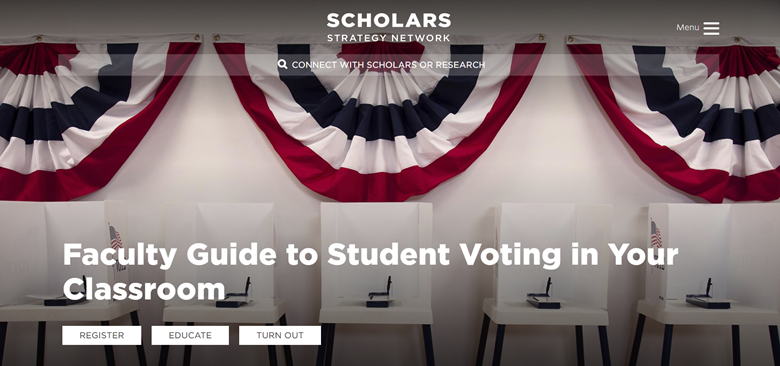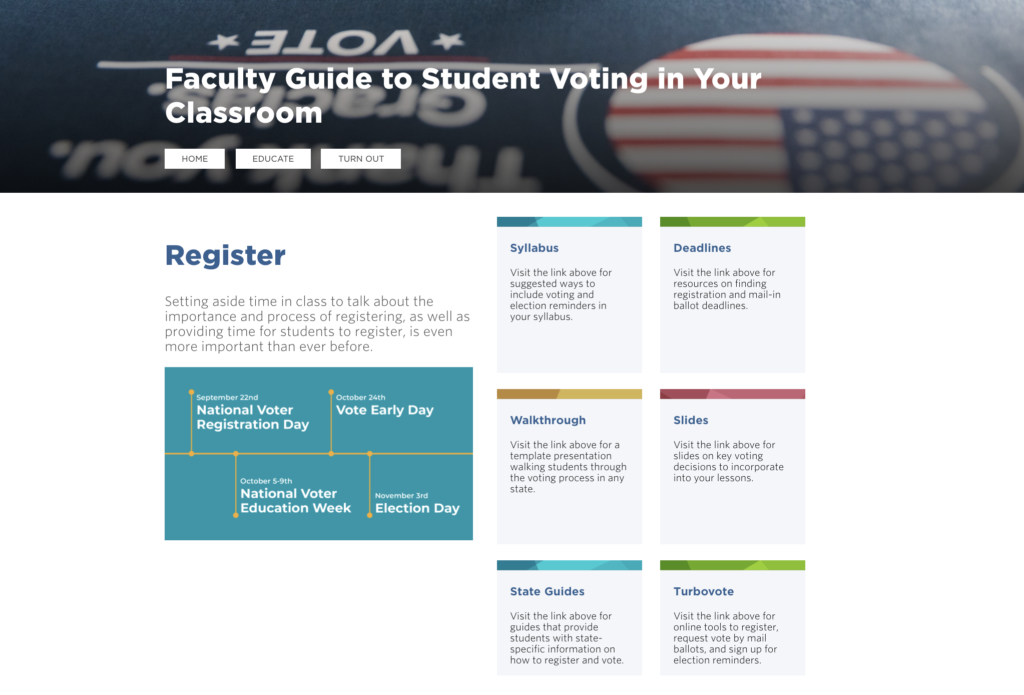October 12, 2020
How faculty can help increase STEM student voter turnout (and turnout across all disciplines)
Posted by Caitlin Bergstrom
 by Samantha Perlman, Civic Engagement Manager, Scholars Strategy Network & Melissa Varga, Science Network Community Manager & Partnerships Coordinator
by Samantha Perlman, Civic Engagement Manager, Scholars Strategy Network & Melissa Varga, Science Network Community Manager & Partnerships Coordinator
With U.S. elections right around the corner, we are all wondering how this unprecedented election will play out. As a deadly pandemic disrupts voting, and rampant and viral misinformation spreads throughout the country, concerns among the public about the integrity of our voting systems are understandably heightened. During this difficult time, our work for research-informed policy is more crucial than ever. As scholars and scientists concerned about our democracy, we need to consider what we know about populations who vote at lower rates, like students and young people, who may be further marginalized during this unconventional election. For example, we know that STEM majors have historically voted at lower rates than students in any other field of study. But we also know that student voter turnout rates have been increasing across the board– jumping from 19% in 2014 to 40% in 2018– a trend we hope to see continue despite the challenging circumstances in 2020.
The transition to virtual classes means that colleges and universities have been unable to engage in traditional in-person methods, like voter registration drives, educational events and turnout initiatives, and have been looking for other creative ideas. As campuses quickly made adjustments to their daily structure, faculty began to play even more pivotal roles than normal, serving as communicators and disseminators of critical information. In the absence of all the structures and routines that define a typical college experience – extracurriculars, social events, academic conferences – one foundational element, classes, has remained, and become more critical than ever.
At Scholars Strategy Network, we work with a diverse group of more than 1600 academics across the country to use research to strengthen democracy. Over the past few months, we heard countless times from our members that they were excited, but simultaneously overwhelmed by the wide range of student voting resources. Especially for those newer to student voting, how could they break down this information for their classroom?
To answer their call, we partnered with Science Rising, a network focused on increasing STEM student voter turnout, to ensure that we were reaching STEM faculty and increasing civic engagement across all disciplines. We started by combing through all of the incredible resources of partner organizations and then categorizing them to make them user-friendly for faculty: registration, education and turnout. The result? Our Faculty Guide to Student Voting in Your Classroom: a starting point and resource compilation for faculty.
Registration: These core resources that make it easy for faculty to set aside a few minutes of class time to talk about the importance of voter registration for eligible students, and simple tools to do so (online or in person). There are sample slides, template language for syllabi, links to reputable websites with in-depth state-specific information, and more.
Education: When faculty connect the election to policies and societal issues students hear about in the news, it can help them build a deeper understanding of how elections relate to their daily lives. Resources in this section include readings on how to discuss civic learning and democratic engagement in the classroom.
Turn out: Here, we focused on tangible tools faculty can use to make sure students have the information they need to vote, whether that’s by mail or in person. It also includes opportunities for students to engage in the election in other ways, including by signing up to be a poll worker or how to participate if you’re not eligible to vote.
Faculty across all disciplines can utilize these resources to make sure their students have the tools and resources they need to engage in this election. and also start building lifelong habits of participating in our democracy. Another great way to continue faculty engagement is through joining the Faculty Network for Student Voting Rights, a new initiative here at SSN led by faculty who are dedicated to equipping all students with the tools and knowledge required to successfully exercise their right to vote.
We’ve also been heartened to see so much energy this election cycle from STEM students and faculty, who, despite their historically low turnout, are mobilizing to vote at higher rates than ever before by encouraging their peers to register, hosting online discussions about science issues that are on the ballot, and embracing the idea of scientists as engaged participants in our democracy.
Another opportunity specifically geared towards the science community is the Science Rising Challenge, which offers a range of evidence-based ways to increase voter registration and engagement, such as recruiting friends to vote, making a plan to vote, and bringing democracy to the classroom. As a complement to the faculty network resources listed above, students can engage their professors to make sure they integrate important registration and election information into all of their classes.
Despite all the challenges 2020 has thrown at us, it is critical that everyone who is eligible casts their ballot this November. Faculty and students in particular have a critical role to play in continuing the trend of higher student voter turnout–let’s make 2020 the year of the highest student voter turnout yet!


